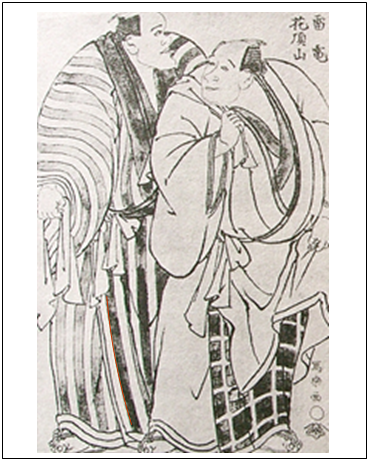[ Daidozan Dohyoiri]
top MOA museum collection
bottom Takamizawa's Taisho Reprint
MOA museum in Japan has one of the last works by Sharaku.
I have seen the reproduction of this horizontally oblong picture several times without paying so much attention.
Acording to the commentary the sumo-wrestlers are watching the child sumo-wrestler in the ring.
As an illustrstion there are several mistakes: both sides of the ring are missing; the poles are too narrow to hide the back of the sword-carriers.
Recently I found this Takamizawa's Taisho Reprint of [Daidozan Dohyoiri] online
and realized this is a masterpiece when it is seen as three pieces side by side.
Obviously the three pictures are not to be connected but to be put side by side like the reprint.
Three pannels look very harmonious in spite of separated pictures because they are made of the same circle-arcs, which the model can confirm us.
Shraku [Daidozan] left circle-arc model
Sharaku [Daidozan] left arc model
Sharaku Daidozan] center circle-arc model
Sharaku [Daidozan] center arc model
Sharaku [Daidozan right circle-arc model
Sharaku [Daidozan right arc model
Puting the three circle models together, we can check the relation on the basic structure level.
I have shown that Sharaku always used the largest circle and the second largest circle to make basic structure.
As we see no conection of the two circles(red brown and yellow)between the three panels it is obvious that each work was structured separately.
The use of unit arcs creates sense of harmony.
Great artists start using the grammar unconsciously.
Some of them eventually reach the level of syntax.
Modern art era was the age of syntax.
This century is the time of analyzing the digital images of the all masterpieces in art history.
Then, I hope, we can restart making unique artworks.
AI chess player beat the human champion.
The chess champion became less heroic.
But the maker of the AI is the new champion.



















